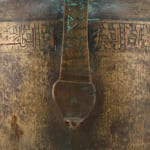Seljuk Ewer, with incised Kufic Inscription, 12th Century CE
Bronze
height 37.5 cm
height 14 3/4 in
height 14 3/4 in
ES.4247
Further images
This splendid bronze ewer stands on a short foot and has a cylindrical body with flat shoulders, a long flaring neck terminating with a tapering spout as well as a...
This splendid bronze ewer stands on a short foot and has a cylindrical body with flat shoulders, a long flaring neck terminating with a tapering spout as well as a loop handle with a thumb stopper connecting the body to the neck. The body is finely engraved with foliate scrolls, foliate roundels, as well as Arabic inscriptions, making this piece a masterpiece of detail.
The Seljuk Empire was a high medieval, culturally Turco-Persian, Sunni Muslim empire, founded and ruled by the Qïnïq branch of Oghuz Turks. It spanned over a large area, from Anatolia and the Levant in the west to the Hindu Kush in the east, and from Central Asia in the north to the Persian Gulf in the south. In the 11th century, the empire separated into different branches of the same dynasty due to internal divisions, with the Great Seljuk being the main branch and maintaining control over Iran. Under the Seljuk sultanate, Iran underwent a period of cultural prosperity, during which material culture and art flourished. These fruitful cultural developments were influential even beyond the sultanate's political influence, with many superb examples of artefacts made in Seljuk style which are dated to the late 12th and 13th centuries and likely represent the work of local dynasties.
Among the most important artistic development of the Seljuk period we find the art of inlaying bronze or brass objects with precious metals such as copper, silver and gold. These objects were usually decorated with Arabic inscriptions where letters were often "transformed" into human and animal figures. Generally, metal objects were made by casting and forging and were decorated with pierced, engraved, relief and inlaying and enamelling techniques, which were often adopted in combination with the same object.
The Seljuk Empire was a high medieval, culturally Turco-Persian, Sunni Muslim empire, founded and ruled by the Qïnïq branch of Oghuz Turks. It spanned over a large area, from Anatolia and the Levant in the west to the Hindu Kush in the east, and from Central Asia in the north to the Persian Gulf in the south. In the 11th century, the empire separated into different branches of the same dynasty due to internal divisions, with the Great Seljuk being the main branch and maintaining control over Iran. Under the Seljuk sultanate, Iran underwent a period of cultural prosperity, during which material culture and art flourished. These fruitful cultural developments were influential even beyond the sultanate's political influence, with many superb examples of artefacts made in Seljuk style which are dated to the late 12th and 13th centuries and likely represent the work of local dynasties.
Among the most important artistic development of the Seljuk period we find the art of inlaying bronze or brass objects with precious metals such as copper, silver and gold. These objects were usually decorated with Arabic inscriptions where letters were often "transformed" into human and animal figures. Generally, metal objects were made by casting and forging and were decorated with pierced, engraved, relief and inlaying and enamelling techniques, which were often adopted in combination with the same object.













